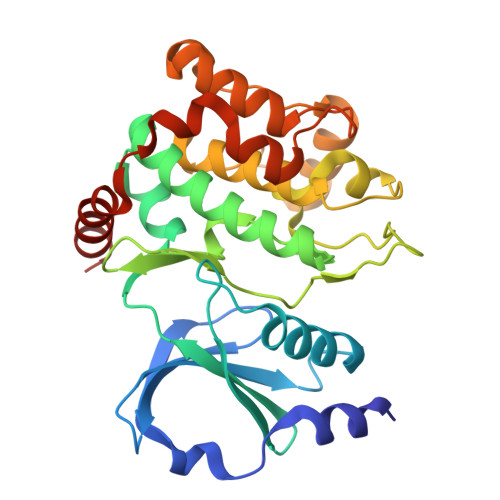Identification of a p21-activated kinase 1 (PAK1) inhibitor with 10-fold selectivity against PAK2.
Johns, D.M., Olejniczak, J., Babbar, A., Boone, C.D., Cakici, O., Cheng, M., Cheng, Q.Q., Dementiev, A., Eick, M., Ferdyan, N., Fontano, E., Forman, A., Kozlowski, R., Lee, S.W., Mehta, S., Mowery, K., Murray, B., Nguyen, V., Olland, A., Phan, K.B., Rivera, L., Sabat, M., Sprengeler, P., Srinivasan, K., Sun, Z., Suto, R.K., Wilkinson, T., Wang, C., Yu, N., Xu, M., Goel, V., Hirst, G., Reich, S.(2025) Bioorg Med Chem Lett 127: 130307-130307
- PubMed: 40516764
- DOI: https://doi.org/10.1016/j.bmcl.2025.130307
- Primary Citation of Related Structures:
9D4V, 9D4W, 9D4X, 9D4Y, 9D50, 9D51, 9D52, 9D53 - PubMed Abstract:
The p21-activated kinases (PAKs) are noted for their role in cytoskeletal organization, cellular morphogenesis, and pro-survival signaling. PAK1 is of particular interest due to its role in tumorigenesis, being amplified in multiple cancers (the most prevalent being breast, ovarian, and melanoma cancers). PAK2 is closely related to PAK1 in structure but is associated with cardiotoxicity. A structure-based design effort targeting a PAK1 (over PAK2) selective small molecule inhibitor is detailed herein. We report here the first crystal structure of PAK2 and use this crystal structure to design a PAK1 inhibitor with ten-fold selectivity over PAK2.
- Turning Point Therapeutics, Inc. (a wholly owned subsidiary of Bristol Myers Squibb Company), 10628 Science Center Drive, Suite 200, San Diego, CA 92121, United States. Electronic address: deidre123@gmail.com.
Organizational Affiliation:

















